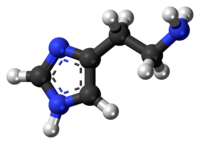Histamine
 |
|
 |
|
| Names | |
|---|---|
|
IUPAC name
2-(1H-Imidazol-4-yl)ethanamine
|
|
| Identifiers | |
|
51-45-6 |
|
| 3D model (Jmol) | Interactive image |
| ChEBI |
CHEBI:18295 |
| ChEMBL |
ChEMBL90 |
| ChemSpider |
753 |
| ECHA InfoCard | 100.000.092 |
| 1204 | |
| KEGG |
D08040 |
| MeSH | Histamine |
| PubChem | 774 |
| UNII |
820484N8I3 |
|
|
|
|
| Properties | |
| C5H9N3 | |
| Molar mass | 111.15 g·mol−1 |
| Melting point | 83.5 °C (182.3 °F; 356.6 K) |
| Boiling point | 209.5 °C (409.1 °F; 482.6 K) |
| Easily soluble in cold water, hot water | |
| Solubility in other solvents | Easily soluble in methanol. Very slightly soluble in diethyl ether. Easily soluble in ethanol. |
| log P | −0.7 |
| Acidity (pKa) |
Imidazole: 6.04 Terminal NH2: 9.75 |
| Pharmacology | |
| L03AX14 (WHO) V04CG03 (WHO) (phosphate) | |
|
Except where otherwise noted, data are given for materials in their standard state (at 25 °C [77 °F], 100 kPa).
|
|
|
|
|
| Infobox references | |
Histamine is an organic nitrogenous compound involved in local immune responses as well as regulating physiological function in the gut and acting as a neurotransmitter. Histamine is involved in the inflammatory response and has a central role as a mediator of pruritus. As part of an immune response to foreign pathogens, histamine is produced by basophils and by mast cells found in nearby connective tissues. Histamine increases the permeability of the capillaries to white blood cells and some proteins, to allow them to engage pathogens in the infected tissues.
Histamine base, obtained as a mineral oil mull, melts at 83–84 °C. Hydrochloride and phosphorus salts form white hygroscopic crystals and are easily dissolved in water or ethanol, but not in ether. In aqueous solution, histamine exists in two tautomeric forms: Nπ-H-histamine and Nτ-H-histamine. The imidazole ring has two nitrogens. The nitrogen farthest away from the side chain is the 'tele' nitrogen and is denoted by a lowercase tau sign. The nitrogen closest to the side chain is the 'pros' nitrogen and is denoted by the pi sign. The position of the nitrogen with the hydrogen on it determines how the tautomer is named. If the nitrogen with the hydrogen is in the tele position, then histamine is in the tele-tautomer form. The tele-tautomer is preferred in solution.
Histamine has two basic centres, namely the aliphatic amino group and whichever nitrogen atom of the imidazole ring does not already have a proton. Under physiological conditions, the aliphatic amino group (having a pKa around 9.4) will be protonated, whereas the second nitrogen of the imidazole ring (pKa ≈ 5.8) will not be protonated. Thus, histamine is normally protonated to a singly charged cation.
...
Wikipedia
